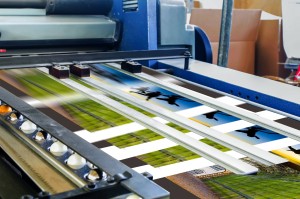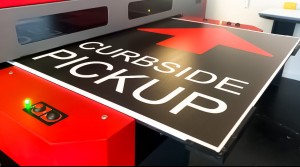Offset printing
Offset printing, also called offset lithography, is a method of mass-production printing in which the images on metal plates are transferred (offset) to rubber blankets or rollers and then to the print media. The print media, usually paper, does not come into direct contact with the metal plates.
UV printing
UV printing is one of the most flexible and exciting direct-to-object print processes ever created, and its uses are almost limitless. UV printing is a distinctive form of digital printing that involves the use of ultraviolet (UV) light to cure or dry UV ink almost as soon as it is applied to a prepared substrate. The substrate can include paper as well as any other material that the printer can accept. This can be foam board, aluminum, or acrylic. As the UV ink is distributed onto the substrate, specialized ultraviolet lights within the printer are immediately applied to the material over the top of the ink, drying it and adhering it to the substrate.
UV inks dry through a photomechanical process. The inks are exposed to ultra-violet lights as they are printed, immediately turning from a liquid to a solid with very little evaporation of solvents and almost no absorption of the ink into the paper stock. So you can print on virtually whatever you want when using UV inks!
Since they dry immediately and release no VOC’s into the environment, UV printing is considered a green technology, safe for the environment and leaving an almost zero carbon footprint.
The printing process is almost exactly the same for both conventional and UV printing; the difference comes in the inks and the drying process associated with those inks. Conventional offset printing uses solvent inks – which are not the greenest option – because they evaporate into the air, releasing VOC’s.
Advantages of Offset Printing
- Large batch printing is cost-effective
- The more copies you print of a single original
- the less each piece costs
- Exceptional color matching
- Offset printers are capable of large-format printing
- Highest quality printing with superior clarity
Disadvantages to Offset Printing
- Laborious and time-consuming setup
- Small batch printing is too slow and too expensive
- Energy-intensive, requiring the creation of multiple aluminum plates for each page
- Solvent-based inks release volatile organic compounds (VOCs) when they dry.
Advantages of UV Printing
- Increased efficiency and time saving because the UV printer can cure the ink immediately.
- Increased durability because the UV cured ink is more resistant to damage like scratches and scuffs.
- Eco friendly because that UV curing process emit zero VOCs.
- Time saving and eco friendly because that UV printing does not need the lamination which is plastic material.
Disadvantages of UV Printing
- UV printers are much more expensive than the offset printers.
27th July by Yuki
Post time: Jul-27-2023


